Charles François de Mondion
Charles François de Mondion (6 October 1681 – 25 December 1733) was a French architect and military engineer who was active in Hospitaller Malta in the early 18th century. He was also a member of the Order of Saint John.[1]
Charles François de Mondion | |
|---|---|
| Born | 6 October 1681 |
| Died | (aged 52) |
| Resting place | Chapel of St Anthony, Fort Manoel 35°54′11.4″N 14°30′18.4″E |
| Nationality | French |
| Occupation(s) | Architect and military engineer |
| Notable work | Various buildings in Mdina, and several fortifications in the Maltese Islands |
| Style | Baroque |
Career
Mondion was born in Paris, and he studied military engineering under Sébastien Le Prestre de Vauban. He first arrived in Malta in 1715 during the magistracy of Grand Master Ramon Perellos y Roccaful of the Order of St. John. His early work was as deputy to the military engineer René Jacob de Tigné. One of his early works was the second Marsalforn Tower, which however no longer exists.[2]
Mondion was eventually admitted into the Order of St. John as a Cavaliere di Grazia, and he obtained permanent residency in Malta.[3]
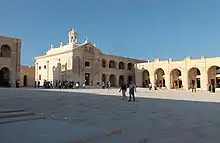
Grand Master António Manoel de Vilhena's accession in June 1722 created a significant opportunity for Mondion, as the new Prince of Malta decided to unleash an ambitious building programme. On 3 November 1722, Vilhena issued orders for the restoration of the former capital Mdina and its fortifications,[4] and entrusted de Mondion with this renovation. Mondion designed a number of Baroque buildings in the city, including the Main Gate, the portal of Greeks Gate, the Torre dello Standardo, Palazzo Vilhena, the Banca Giuratale and the Corte Capitanale.[5]
Mondion was also involved in the construction or modifications of the Floriana Lines,[6] Fort Manoel,[7] the fortifications of Birgu[8] and the Santa Margherita Lines.[9] He designed several gates within these fortifications, including Porte des Bombes and St. Helen's Gate.[10][11]
His unexpected death in 1733 cut short a promising career. Mondion was buried in the crypt of the Chapel of St Anthony of Padua within Fort Manoel.[12]
Gallery
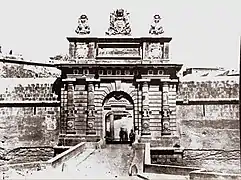 Porte des Bombes (1720–21)
Porte des Bombes (1720–21) Marsalforn Tower (1720–22)
Marsalforn Tower (1720–22)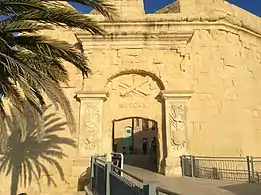 Couvre Porte Gate (1722)
Couvre Porte Gate (1722)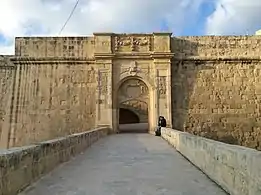 Advanced Gate (1723)
Advanced Gate (1723) Mdina Gate (1724)
Mdina Gate (1724)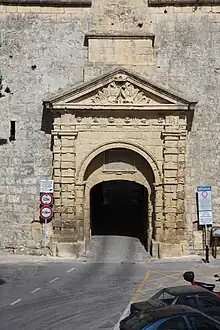 Portal of Greeks Gate (1724)
Portal of Greeks Gate (1724)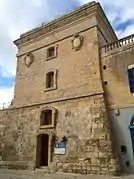 Torre dello Standardo (1725)
Torre dello Standardo (1725)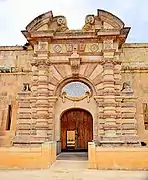 Fort Manoel Gate (1726)
Fort Manoel Gate (1726).jpg.webp) Palazzo Vilhena (1726–28)
Palazzo Vilhena (1726–28)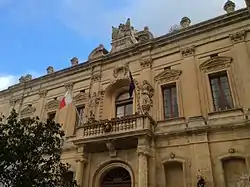 Corte Capitanale (1726–28)
Corte Capitanale (1726–28) Banca Giuratale (1726–28)
Banca Giuratale (1726–28)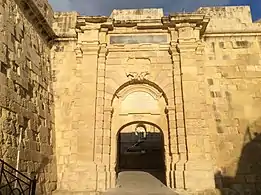 Gate of Provence (1727)
Gate of Provence (1727)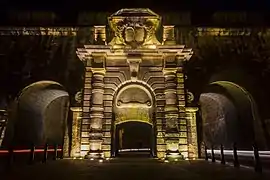 St. Helen's Gate (1736)
St. Helen's Gate (1736)
References
- "Mdina the Silent City | A Place Full of Wonderful Things to do".
- Spiteri, Stephen C. (2013). "In Defence of the Coast (I) - The Bastioned Towers". Arx - International Journal of Military Architecture and Fortification (3): 48. Archived from the original on 15 September 2017. Retrieved 8 May 2015.
- De Lucca, Denis. "The Contribution of François de Mondion in the Architectural Development of 18th Century Malta". militaryarchitecture.com. Archived from the original on 20 December 2017. Retrieved 27 November 2015.
- De Lucca, Denis (1979). "Mdina: Baroque town planning in 18th century Mdina". Heritage: An Encyclopedia of Maltese Culture and Civilization. Midsea Books Ltd. 1: 21–25.
- De Lucca, Denis (1979). "Mdina: Mondion's master plan for the old city". Heritage: An Encyclopedia of Maltese Culture and Civilization. Midsea Books Ltd. 1: 53–56.
- Spiteri, Stephen C. (2004–2007). "The Development of the Bastion of Provence, Floriana Lines" (PDF). Arx – Online Journal of Military Architecture and Fortification (1–4): 29–31. Archived from the original (PDF) on 15 November 2015. Retrieved 27 November 2015.
- Spiteri, Stephen C. (2014). "Fort Manoel". ARX Occasional Papers. 4. Archived from the original on 2 May 2018. Retrieved 27 November 2015.
- "St James Bastion - Birgu" (PDF). National Inventory of the Cultural Property of the Maltese Islands. 28 June 2013. Archived from the original (PDF) on 13 July 2015. Retrieved 27 November 2015.
- "St John Almoner Bastion – Sta Margherita Lines" (PDF). National Inventory of the Cultural Property of the Maltese Islands. 28 June 2013. Archived from the original (PDF) on 13 July 2015. Retrieved 27 November 2015.
- De Lucca, Denis (1981). "The contribution of Francois de Mondion in the architectural development of 18th century Malta" (PDF). Proceedings of History Week: 78. Archived from the original (PDF) on 17 April 2016.
- Spiteri, Stephen C. (6 September 2010). "Porta dei Mortari". MilitaryArchitecture.com. Archived from the original on 20 September 2016.
- "Descendant visits Mondion's masterpiece, Fort Manoel". Times of Malta. 31 August 2011. Retrieved 27 November 2015.